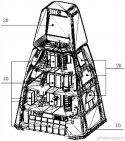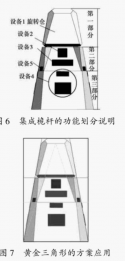With a displacement of 5000+ tons, 054B would have some more flexibility to be equipped with some high-end AAW capabilities, compared with 054A. But it's important to carefully think through its missions before we "give" it a lot of capabilities.
To me, the most important mission for 054B should be the blue-water ASW, presumably within a CBG; a secondary mission would be a general-purpose frigate with blue-water capability (e.g., endurance) that may engage in conflicts of relatively low to medium level intensity not involving CBG.
For the blue-water ASW mission, 054B doesn't need long-range AAW missiles which should be handled by 052D and/or 055. Instead, it should be optimized for ASW. Ideally, I would have dual helicopters in addition to the full suite of ASW sonars/sensors/missiles/rockets. For AAW, I would have all quad-packed medium ranges missiles for self defense and participating in the medium range of fleet defense against saturation attacks. There need clear distinction and division of labor between 054B and 052D/055 in this mission.
For general-purpose blue-water mission, it makes sense to equip 054B with some (limited, mostly by sensor) capability of relatively long-range AAW missiles, either under the guidance of its own sensors or through CEC with other ships (052D/055/075). In this case, you would have a different VLS loadout and probably don't need two helicopters.
So ideally 054B should be able to be configured and equipped to handle the above two different missions.
I agree with your description of the role for 054B -- capable of doing blue water CSG escort (emphasizing ASW and medium range AAW), but also blue water general purpose frigate duties that can operate in low to medium intensity conflicts either by itself or with coordination of some small degree of support from friendly surface units. The latter mission I believe will necessitate a degree of credible LR SAM capability, but it does not need to be as capable as 052D or 055 in that regard.
IMO, there are two differentiating aspects between 052D/055 from 054B in terms of their capability to independently carry out "LR SAM engagements":
1. 052D/055 will be capable of carrying out "VLR SAM engagements" (up to 400km range) while 054B is "limited" to "LR SAM engagements" (200km range category)
2. For "LR SAM engagements" (200km range), the 052D and 055 will be capable of handling greater simultaneous targets from a multi axis attack, than what 054B can manage.
In terms of the effects of 1. and 2. on radar selection -- No.1 will determine the size of the primary radar on 054B, and No. 2 will determine the configuration of the radar.
Personally, I think the twin face S band AESA that we saw on test ship 892 (and which is 99% going to end up on 054B) is a perfect fit for the role described above.
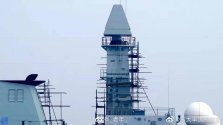
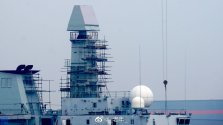
Assuming it is indeed a modern AESA, the arrays on the dual face are each about the size of the larger array on Sea Eagle -- this picture of an 054A alongside an 052D would be a nice indication of just how big the new twin face AESA would be compared to 052D's 346A.
It won't be small -- each array may even have about 2/3rds of the individual array size of 346A..
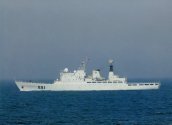
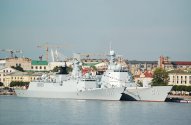
====
Basically, when you are choosing a radar configuration for a ship, there are only so many ways you can configure it in the confines of a given hull.
Various factors will have to be prioritized over another, such as weight, cost, range, 360 degree coverage/refresh rate, horizon range etc.
For a nation like China, operating a large fleet of destroyers with large array four fixed face AESAs, it is reasonable to expect that a frigate class would have a less capable and less costly AESA/sensor set up than the destroyers. However, you still want a capable platform.
In the case of 054B's radar, it appears that they've taken a route similar to the SAMPSON radar, and prioritized these tradeoffs:
- two medium sized array faces: there were basically only three options available to them for choosing a radar configuration to achieve 360 coverage, either four fixed faces where each array was individually quite small, or choose three fixed faces with small-medium sized arrays (similar to Constellation class), or choose two faces on a fast rotating mount (like SAMPSON). Each of those options offers their own pros and cons, but it seems like by choosing a medium sized array, there was a threshold of maximum performance per array that they were not willing to compromise on, and accepted instead that a fast rotating twin face solution would be sufficient for their needs. In essence, they are trading greater radar range/resolution for slightly decreased ability to handle complex multi-axis saturation attacks independently.
- horizon range: by placing the radar higher on a mast, it increases the radar horizon of being able to detect low flying targets, relative to if the radar was placed lower. Of course, placing a radar higher means you cannot make the individual arrays as large as if you placed it lower, but given this is a twin face solution anyhow, and given the 054B is meant to be a relatively economical frigate, it is not a big deal, because their individual array size was always going to have a maximum size anyhow. Indeed, for a frigate like 054B, attaining greater maximum radar horizon would actually be quite a beneficial capability, and if it is placed at a similar height to Sea Eagle on 054A, the radar on 054B will have a higher radar horizon for its primary S band AESA than 052D does for its own S band AESA (Type 346A)! The reason why you cannot put say, a three fixed face radar of the same array size and at the same mast height is because of structural/top heavy reasons.
The SAMPSON is also an S band twin face fast rotating AESA, aboard the Type 45 destroyers. That was a solution that the UK went with for a number of reasons (no least due to financial, but also due to availability/prevalence of other friendly AAW assets that they may have or lack) -- but it is saying something for us to consider that the "economical" 054B may have a primary radar capability that is not far from what the UK's primary AAW destroyer possesses.
The US Constellation class frigate and its SPY-6V3 radar setup makes for an interesting comparison to 054B's radar configuration. The Constellation class faces a similar challenge to 054B, in desiring a capable yet more economical radar system relative to their Burke class destroyers.
But they selected a solution with three fixed face medium-small sized array faces, placed immediately above the deck house structure, but still far lower than 054B's mast mounted radar. For the Constellation class, they prioritized having more consistent 360 degree coverage (using a fixed face configuration), and sacrificing slightly longer range (medium-small sized array), and also sacrificing radar horizon range (mounted atop the deckhouse rather than atop a mast).
Both the 054B's solution and the Constellation class's solution are very reasonable and neither is better than the other -- it's simply a reflection of the competing requirements that favours slightly greater capability in one domain versus another.

